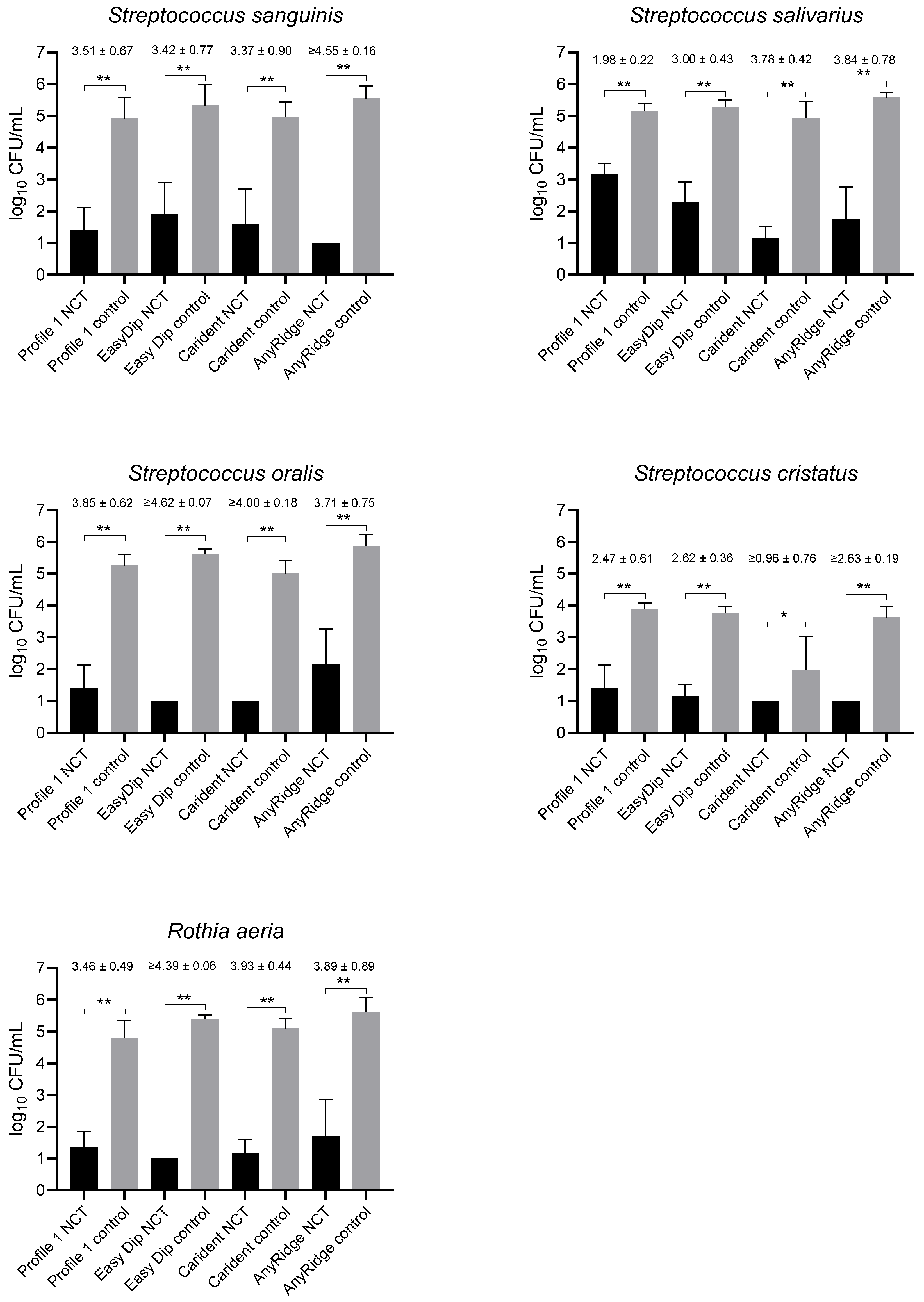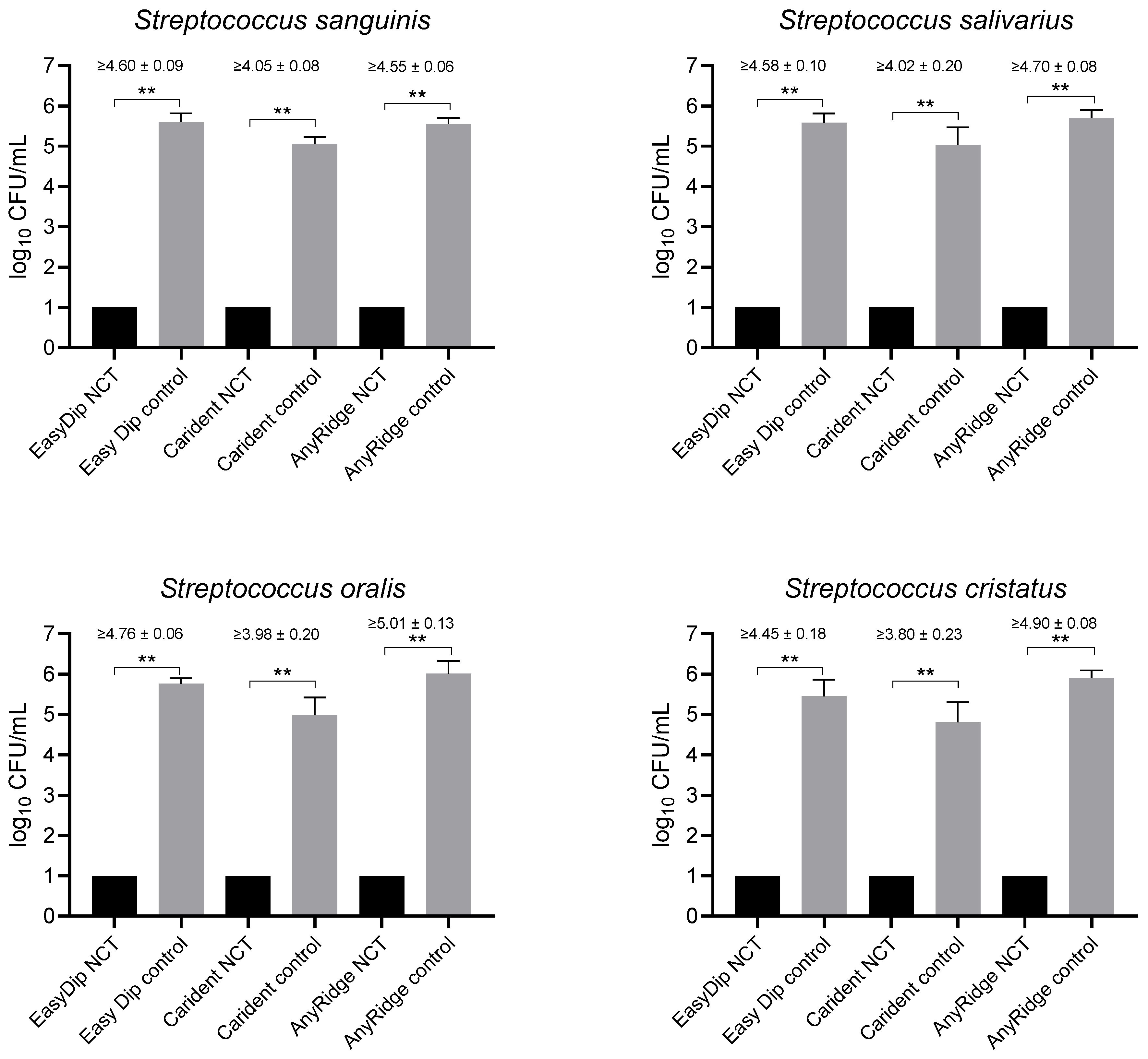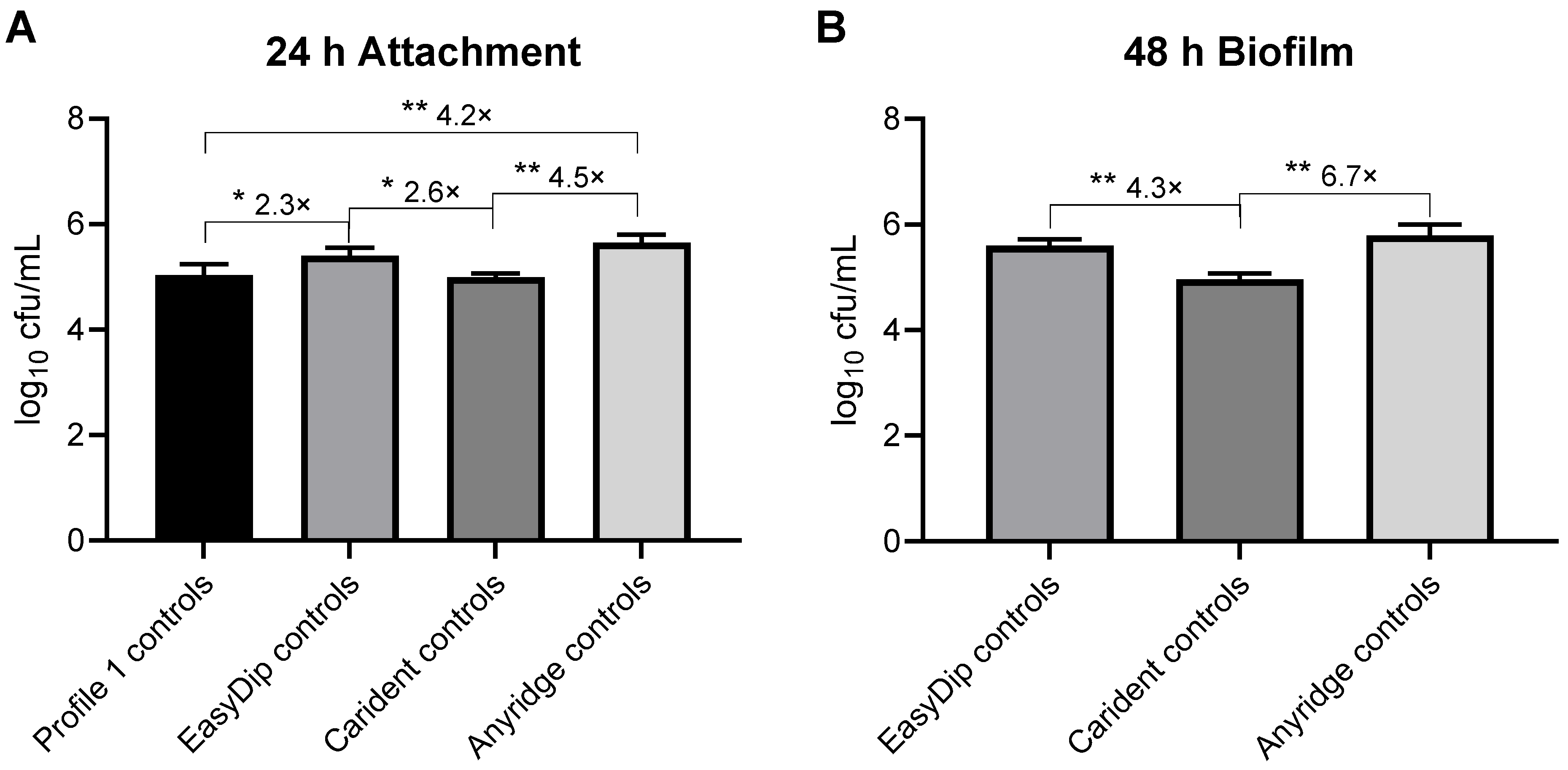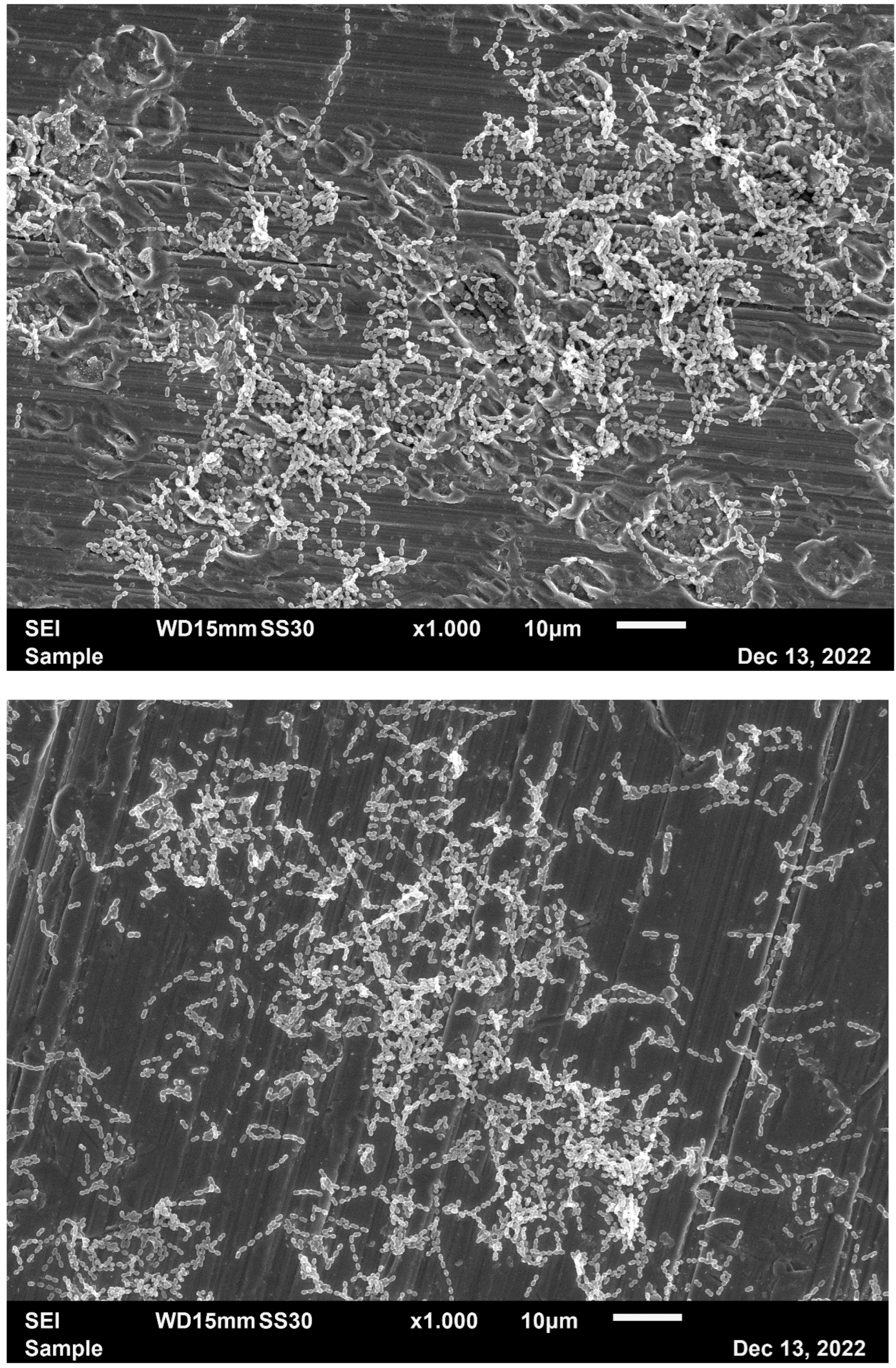Activity of N-Chlorotaurine against Periodontal Pathogens
Abstract
1. Introduction
2. Results
2.1. Activity of N-Chlorotaurine (NCT) against Planktonic Dental Plaque Bacteria in PBS Solution
2.2. Activity of NCT against Planktonic Dental Plaque Bacteria on Dental Implant Screws
2.3. Activity of NCT against Biofilm of Dental Plaque Bacteria on Dental Implant Screws
2.4. Comparison of Attachment of Viable Bacteria on Different Screws
2.5. Scanning Electron Microscopy of Biofilm on Implant Screws
3. Discussion
4. Materials and Methods
4.1. Chemicals
4.2. Test Bacteria
4.3. Quantitative Killing Assays of Planktonic Bacteria
4.4. Quantitative Killing Assays of Planktonic Bacteria on Dental Implant Screws
4.5. Quantitative Killing Assays of Biofilm Bacteria on Dental Implant Screws
4.6. Electron Microscopy of Biofilm on Dental Implant Screws
4.7. Statistics
Author Contributions
Funding
Institutional Review Board Statement
Informed Consent Statement
Data Availability Statement
Acknowledgments
Conflicts of Interest
References
- Socransky, S.S.; Haffajee, A.D.; Cugini, M.A.; Smith, C.; Kent, R.L., Jr. Microbial complexes in subgingival plaque. J. Clin. Periodontol. 1998, 25, 134–144. [Google Scholar] [CrossRef]
- Amano, A. Host-parasite interactions in periodontitis: Microbial pathogenicity and innate immunity. Periodontology 2000 2010, 54, 9–14. [Google Scholar] [CrossRef]
- Lee, Y.H.; Chung, S.W.; Auh, Q.S.; Hong, S.J.; Lee, Y.A.; Jung, J.; Lee, G.J.; Park, H.J.; Shin, S.I.; Hong, J.Y. Progress in Oral Microbiome Related to Oral and Systemic Diseases: An Update. Diagnostics 2021, 11, 1283. [Google Scholar] [CrossRef]
- Brookes, Z.; McGrath, C.; McCullough, M. Antimicrobial Mouthwashes: An Overview of Mechanisms—What Do We Still Need to Know? Int. Dent. J. 2023, 73 (Suppl. S2), S64–S68. [Google Scholar] [CrossRef]
- Frater, M.; Braunitzer, G.; Urban, E.; Bereczki, L.; Antal, M.; Nagy, K. In vitro efficacy of different irrigating solutions against polymicrobial human root canal bacterial biofilms. Acta Microbiol. Immunol. Hung. 2013, 60, 187–199. [Google Scholar] [CrossRef]
- da Costa, L.; Amaral, C.; Barbirato, D.D.S.; Leão, A.T.T.; Fogacci, M.F. Chlorhexidine mouthwash as an adjunct to mechanical therapy in chronic periodontitis: A meta-analysis. J. Am. Dent. Assoc. 2017, 148, 308–318. [Google Scholar] [CrossRef]
- Bescos, R.; Ashworth, A.; Cutler, C.; Brookes, Z.L.; Belfield, L.; Rodiles, A.; Casas-Agustench, P.; Farnham, G.; Liddle, L.; Burleigh, M.; et al. Effects of Chlorhexidine mouthwash on the oral microbiome. Sci. Rep. 2020, 10, 5254. [Google Scholar] [CrossRef]
- Pilz, M.; Staats, K.; Assadian, O.; Windhager, R.; Holinka, J. Tolerability of N-chlorotaurine in comparison with routinely used antiseptics: An in vitro study on chondrocytes. Pharmacol. Rep. 2024. Online ahead of print. [Google Scholar] [CrossRef]
- Gottardi, W.; Nagl, M. N-chlorotaurine, a natural antiseptic with outstanding tolerability. J. Antimicrob. Chemother. 2010, 65, 399–409. [Google Scholar] [CrossRef]
- Murashevych, B.; Girenko, D.; Koshova, I.; Maslak, G.; Burmistrov, K.; Stepanskyi, D. Broad-Purpose Solutions of N-Chlorotaurine: A Convenient Synthetic Approach and Comparative Evaluation of Stability and Antimicrobial Activity. J. Chem. 2024, 2024, 8959915. [Google Scholar] [CrossRef]
- Ximenes, V.F.; Ximenes, T.P.; Morgon, N.H.; de Souza, A.R. Taurine Chloramine and Hydrogen Peroxide as a Potential Source of Singlet Oxygen for Topical Application. Photochem. Photobiol. 2021, 97, 963–970. [Google Scholar] [CrossRef]
- Marcinkiewicz, J. Neutrophil chloramines: Missing links between innate and acquired immunity. Immunol. Today 1997, 18, 577–580. [Google Scholar] [CrossRef]
- Nagl, M.; Hess, M.; Pfaller, K.; Hengster, P.; Gottardi, W. Bactericidal activity of micromolar N-chlorotaurine—Evidence for its antimicrobial function in the human defence system. Antimicrob. Agents Chemother. 2000, 44, 2507–2513. [Google Scholar] [CrossRef]
- Lackner, M.; Rössler, A.; Volland, A.; Stadtmüller, M.; Müllauer, B.; Banki, Z.; Ströhle, J.; Luttick, A.; Fenner, J.; Stoiber, H.; et al. N-chlorotaurine is highly active against respiratory viruses including SARS-CoV-2 (COVID-19) in vitro. Emerg. Microbes Infect. 2022, 11, 1293–1307. [Google Scholar] [CrossRef]
- Anich, C.; Orth-Höller, D.; Lackner, M.; Nagl, M. Microbicidal activity of N-chlorotaurine against multiresistant nosocomial bacteria. J. Appl. Microbiol. 2021, 131, 1742–1748. [Google Scholar] [CrossRef]
- Pasich, E.; Bialecka, A.; Marcinkiewicz, J. Efficacy of taurine haloamines and chlorhexidine against selected oral microbiome species. Med. Dosw. Mikrobiol. 2013, 65, 187–196. [Google Scholar]
- Arentz, M.; Yim, E.; Klaff, L.; Lokhandwala, S.; Riedo, F.X.; Chong, M.; Lee, M. Characteristics and Outcomes of 21 Critically Ill Patients With COVID-19 in Washington State. JAMA 2020, 323, 1612–1614. [Google Scholar] [CrossRef]
- Kim, C.; Cha, Y.N. Taurine chloramine produced from taurine under inflammation provides anti-inflammatory and cytoprotective effects. Amino Acids 2014, 46, 89–100. [Google Scholar] [CrossRef]
- Marcinkiewicz, J.; Nagl, M.; Kyriakopoulos, A.; Walczewska, M.; Skóra, M.; Skalska, P. Current Opinion on the Therapeutic Capacity of Taurine-Containing Halogen Derivatives in Infectious and Inflammatory Diseases. In Taurine 12: A Conditionally Essential Amino Acid (Advances in Experimental Medicine and Biology); Schaffer, S.W., El Idrissi, A., Murakami, S., Eds.; Springer International Publishing: Cham, Switzerland, 2022; Volume 1370, pp. 83–98. [Google Scholar] [CrossRef]
- Marcinkiewicz, J.; Walczewska, M. Neutrophils as Sentinel Cells of the Immune System: A Role of the MPO-halide-system in Innate and Adaptive Immunity. Curr. Med. Chem. 2020, 27, 2840–2851. [Google Scholar] [CrossRef]
- Kim, H.J.; Kang, I.S.; Kim, C. Taurine Chloramine Inhibits Leukocyte Migration by Suppressing Actin Polymerization and Extracellular Signal-Regulated Kinase. Adv. Exp. Med. Biol. 2022, 1370, 51–61. [Google Scholar] [CrossRef]
- Kim, D.G.; Kwon, Y.M.; Kang, I.S.; Kim, C. Taurine chloramine selectively regulates neutrophil degranulation through the inhibition of myeloperoxidase and upregulation of lactoferrin. Amino Acids 2020, 52, 1191–1199. [Google Scholar] [CrossRef]
- Mainnemare, A.; Megarbane, B.; Soueidan, A.; Daniel, A.; Chapple, I.L. Hypochlorous acid and taurine-N-monochloramine in periodontal diseases. J. Dent. Res. 2004, 83, 823–831. [Google Scholar] [CrossRef]
- Lorenz, K.; Mayer, D.; Bruhn, G.; Noack, B.; Brecx, M.; Heumann, C.; Toutenburg, H.; Netuschil, L.; Nagl, M.; Gottardi, W.; et al. Effect of N-chlorotaurine mouth rinses on plaque regrowth and plaque vitality. Clin. Oral. Investig. 2009, 13, 9–14. [Google Scholar] [CrossRef]
- Di Traglia, R.; Tudor-Green, B.; Muzaffar, J.; Borsetto, D.; Smith, M.E. Antibiotics versus non-antibiotic treatments for acute otitis externa: A systematic review and meta-analysis. Clin. Otolaryngol. 2023, 48, 841–862. [Google Scholar] [CrossRef]
- Speth, C.; Rambach, G.; Windisch, A.; Neurauter, M.; Maier, H.; Nagl, M. Efficacy of inhaled N-chlorotaurine in a mouse model of Lichtheimia corymbifera and Aspergillus fumigatus pneumonia. J. Fungi 2022, 2022, 535. [Google Scholar] [CrossRef]
- Stenzl, A.; Nagl, M.; Pregenzer, B.; Letzner, K.H.; Pregenzer, L.; Insam, H.; Stenzl, A. N-Chlorotaurine—A New Antiseptic for Root Canal Treatment? Adv. Biochem. Biotech. 2018, 3, 154. [Google Scholar]
- Tuganbaev, T.; Yoshida, K.; Honda, K. The effects of oral microbiota on health. Science 2022, 376, 934–936. [Google Scholar] [CrossRef]
- Stojicic, S.; Shen, Y.; Haapasalo, M. Effect of the source of biofilm bacteria, level of biofilm maturation, and type of disinfecting agent on the susceptibility of biofilm bacteria to antibacterial agents. J. Endod. 2013, 39, 473–477. [Google Scholar] [CrossRef]
- Ammann, C.; Fille, M.; Hausdorfer, J.; Nogler, M.; Nagl, M.; Coraca-Huber, D.C. Influence of Poly-N-acetylglucosamine in the extracellular matrix on N-Chlorotaurine mediated killing of Staphylococcus epidermidis. New Microbiol. 2014, 37, 383–386. [Google Scholar]
- Coraca-Huber, D.C.; Ammann, C.; Fille, M.; Hausdorfer, J.; Nogler, M.; Nagl, M. Bactericidal activity of N-chlorotaurine against biofilm forming bacteria grown on metal discs. Antimicrob. Agents Chemother. 2014, 58, 2235–2239. [Google Scholar] [CrossRef][Green Version]
- Grimus, V.; Coraca-Huber, D.C.; Steixner, S.; Nagl, M. Activity of N-chlorotaurine against long-term biofilms of bacteria and yeasts. Antibiotics 2021, 10, 891. [Google Scholar] [CrossRef]
- Efimenko, A.O.; Stepanskyi, O.D.; Bogomolny, L.O.; Ishchenko, O.V. Effect of N-chlorotaurine on biofilms of pathogens associated with complications of dental implantation. Bull. Probl. Biol. Med. 2023, 169, 432–437. [Google Scholar] [CrossRef]
- Neher, A.; Fischer, H.; Appenroth, E.; Lass-Flörl, C.; Mayr, A.; Gschwendtner, A.; Ulmer, H.; Gotwald, T.F.; Gstöttner, M.; Kozlov, V.; et al. Tolerability of N-Chlorotaurine in Chronic Rhinosinusitis Applied via Yamik Catheter. Auris Nasus Larynx 2005, 32, 359–364. [Google Scholar] [CrossRef]
- Arnitz, R.; Stein, M.; Bauer, P.; Lanthaler, B.; Jamnig, H.; Scholl-Bürgi, S.; Stempfl-Al-Jazrawi, K.; Ulmer, H.; Baumgartner, B.; Embacher, S.; et al. Tolerability of inhaled N-chlorotaurine in humans—A double-blind randomized phase I clinical study. Ther. Adv. Respir. Dis. 2018, 12, 1–14. [Google Scholar] [CrossRef]
- Schwarz, C.; Lackner, M.; Eschenhagen, P.; Nagl, M. N-chlorotaurine is a very promising antiseptic treatment option for multiresistant bacteria, fungi and for viruses including SARS-CoV-2. J. Cyst. Fibros. 2021, 20 (Suppl. S1), S36. [Google Scholar] [CrossRef]
- Cegolon, L.; Mastrangelo, G.; Bellizzi, S.; Filon, F.L.; Salata, C. Supporting the Aspecific Physiological Defenses of Upper Airways against Emerging SARS-CoV-2 Variants. Pathogens 2023, 12, 211. [Google Scholar] [CrossRef]
- Kim, S.H.; Yum, H.W.; Kim, S.H.; Kim, W.; Kim, S.J.; Kim, C.; Kim, K.; Suh, Y.G.; Surh, Y.J. Protective Effects of Taurine Chloramine on Experimentally Induced Colitis: NFκB, STAT3, and Nrf2 as Potential Targets. Antioxidants 2021, 10, 479. [Google Scholar] [CrossRef]
- Kim, S.J.; Yum, H.W.; Kim, S.H.; Kim, S.J.; Kim, K.; Kim, C.; Suh, Y.G.; Surh, Y.J. Topically Applied Taurine Chloramine Protects against UVB-Induced Oxidative Stress and Inflammation in Mouse Skin. Antioxidants 2021, 10, 867. [Google Scholar] [CrossRef]
- Marcinkiewicz, J.; Kontny, E. Taurine and inflammatory diseases. Amino Acids 2014, 46, 7–20. [Google Scholar] [CrossRef]
- Khanh Hoang, N.; Maegawa, E.; Murakami, S.; Schaffer, S.W.; Ito, T. N-Chlorotaurine Reduces the Lung and Systemic Inflammation in LPS-Induced Pneumonia in High Fat Diet-Induced Obese Mice. Metabolites 2022, 12, 349. [Google Scholar] [CrossRef]
- Clark, A.E.; Kaleta, E.J.; Arora, A.; Wolk, D.M. Matrix-assisted laser desorption ionization-time of flight mass spectrometry: A fundamental shift in the routine practice of clinical microbiology. Clin. Microbiol. Rev. 2013, 26, 547–603. [Google Scholar] [CrossRef]
- Gottardi, W.; Pfleiderer, J.; Nagl, M. The Integral Method, a new approach to quantify bactericidal activity. J. Microbiol. Methods 2015, 115, 71–78. [Google Scholar] [CrossRef]





| Species | 1% NCT 37 °C | 1% NCT 20 °C | 0.1% NCT 37 °C | Controls |
|---|---|---|---|---|
| S. sanguinis | 0.4063 ± 0.0395 | 0.2310 ± 0.0187 | 0.0891 ± 0.0133 | 0.0072 ± 0.0100 |
| S. salivarius | 0.2782 ± 0.0583 | 0.1998 ± 0.0278 | 0.0911 ± 0.0116 | −0.0120 ± 0.0148 |
| S. oralis | 0.4009 ± 0.0726 | 0.3262 ± 0.0465 | 0.1781 ± 0.0257 | −0.0006 ± 0.0152 |
| S. cristatus | 0.3483 ± 0.0440 | 0.1669 ± 0.0217 | 0.1446 ± 0.0152 | 0.0060 ± 0.0135 |
| C. ochracea | 0.6239 ± 0.0603 | 0.4266 ± 0.0346 | not done | 0.0037 ± 0.0210 |
| R. aeria | 0.1878 ± 0.0233 | 0.1262 ± 0.0159 | 0.0611 ± 0.0079 | 0.0082 ± 0.0062 |
| Screw Type | Size | Lot |
|---|---|---|
| Easy Dip a | ø 4.75 mm, L 13 mm | Ref. ED47513, lot 2012/0004/1 |
| Easy Dip a | ø 4.75 mm, L 11.5 mm | Ref. ED475115, lot 2012/0033 |
| Easy Dip a | ø 4.75 mm, L 10 mm | Ref. ED47510, lot 2012/0025/2 |
| Carident b | ø 3.6 mm, L 8 mm | Ref: A-03-036080, lot 611600, lot 604194 |
| Carident b | ø 4.2 mm, L 8 mm | Ref: A-03-042080, lot 611602 |
| Carident b | ø 3.6 mm, L 10 mm | Ref: A-03-036100, lot 611601 |
| AnyRidge c | ø 8 mm, L 7 mm | Ref: FALIHX8007C, lot: 170512A1030-01 |
| AnyRidge c | ø 3.5 mm, L 7 mm | Ref: FANIHX3507C, lot: 170427A0440-01 |
| AnyRidge c | ø 6.5 mm, L 10 mm | Ref: FALIHX6510C, lot: 170825A1130-01 |
| AnyRidge c | ø 8 mm, L 13 mm | Ref: FALIHX8013C, lot: 170502A1270-02 |
| Profile1 DeepNeck d | ø 4 mm, L 8 mm | Ref: P1W4008R, lot: 2011/0359/1 |
Disclaimer/Publisher’s Note: The statements, opinions and data contained in all publications are solely those of the individual author(s) and contributor(s) and not of MDPI and/or the editor(s). MDPI and/or the editor(s) disclaim responsibility for any injury to people or property resulting from any ideas, methods, instructions or products referred to in the content. |
© 2024 by the authors. Licensee MDPI, Basel, Switzerland. This article is an open access article distributed under the terms and conditions of the Creative Commons Attribution (CC BY) license (https://creativecommons.org/licenses/by/4.0/).
Share and Cite
Kowalczyk, K.; Coraça-Huber, D.C.; Wille-Kollmar, W.; Berktold, M.; Nagl, M. Activity of N-Chlorotaurine against Periodontal Pathogens. Int. J. Mol. Sci. 2024, 25, 8357. https://doi.org/10.3390/ijms25158357
Kowalczyk K, Coraça-Huber DC, Wille-Kollmar W, Berktold M, Nagl M. Activity of N-Chlorotaurine against Periodontal Pathogens. International Journal of Molecular Sciences. 2024; 25(15):8357. https://doi.org/10.3390/ijms25158357
Chicago/Turabian StyleKowalczyk, Kacper, Débora C. Coraça-Huber, Walter Wille-Kollmar, Michael Berktold, and Markus Nagl. 2024. "Activity of N-Chlorotaurine against Periodontal Pathogens" International Journal of Molecular Sciences 25, no. 15: 8357. https://doi.org/10.3390/ijms25158357
APA StyleKowalczyk, K., Coraça-Huber, D. C., Wille-Kollmar, W., Berktold, M., & Nagl, M. (2024). Activity of N-Chlorotaurine against Periodontal Pathogens. International Journal of Molecular Sciences, 25(15), 8357. https://doi.org/10.3390/ijms25158357






